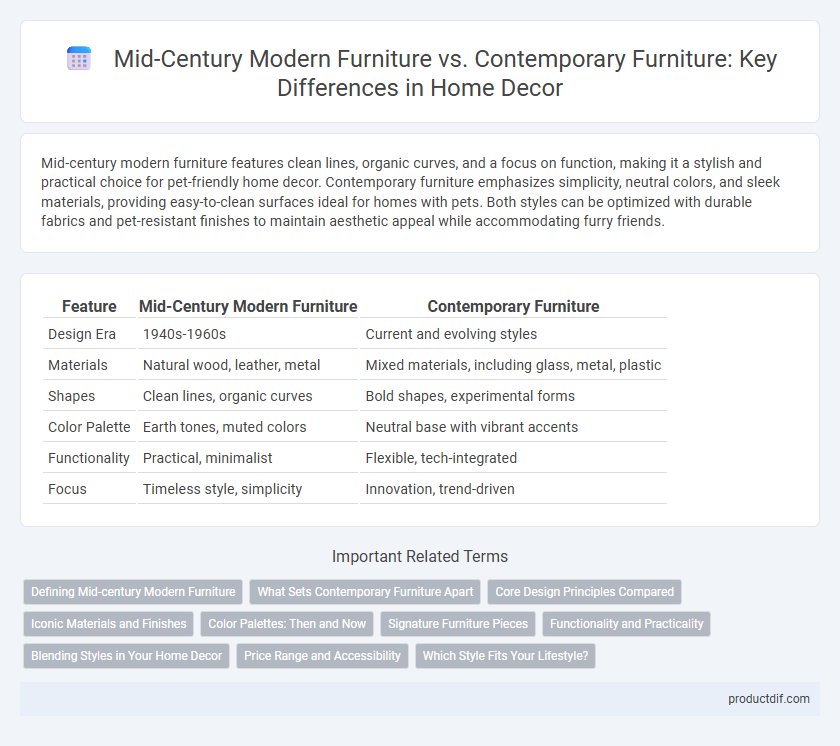Mid-century modern furniture features clean lines, organic curves, and a focus on function, making it a stylish and practical choice for pet-friendly home decor. Contemporary furniture emphasizes simplicity, neutral colors, and sleek materials, providing easy-to-clean surfaces ideal for homes with pets. Both styles can be optimized with durable fabrics and pet-resistant finishes to maintain aesthetic appeal while accommodating furry friends.
Table of Comparison
| Feature | Mid-Century Modern Furniture | Contemporary Furniture |
|---|---|---|
| Design Era | 1940s-1960s | Current and evolving styles |
| Materials | Natural wood, leather, metal | Mixed materials, including glass, metal, plastic |
| Shapes | Clean lines, organic curves | Bold shapes, experimental forms |
| Color Palette | Earth tones, muted colors | Neutral base with vibrant accents |
| Functionality | Practical, minimalist | Flexible, tech-integrated |
| Focus | Timeless style, simplicity | Innovation, trend-driven |
Defining Mid-century Modern Furniture
Mid-century modern furniture is characterized by clean lines, organic curves, and a minimalist aesthetic that emerged between the 1940s and 1960s, emphasizing functionality and simplicity. Typically crafted from natural materials like wood, leather, and metal, it highlights neutral tones paired with bold accent colors. This style contrasts with contemporary furniture, which prioritizes current trends and often incorporates a broader range of materials and design influences.
What Sets Contemporary Furniture Apart
Contemporary furniture stands out through its emphasis on clean lines, minimalist forms, and innovative use of materials like metal, glass, and sustainable composites. Unlike mid-century modern designs that highlight organic shapes and wooden elements, contemporary pieces often incorporate sleek finishes and multifunctional features suited for modern living spaces. This style prioritizes adaptability and comfort while reflecting current design trends and technological advancements.
Core Design Principles Compared
Mid-century modern furniture emphasizes clean lines, organic shapes, and functional design with natural wood tones, reflecting simplicity and minimal ornamentation. Contemporary furniture prioritizes sleek, smooth surfaces, neutral colors, and innovative materials like metal and glass, highlighting adaptability and comfort. Both styles value practicality but differ in their use of textures, forms, and color palettes to create distinct aesthetic atmospheres.
Iconic Materials and Finishes
Mid-century modern furniture showcases iconic materials such as molded plywood, teak wood, and fiberglass, with finishes emphasizing natural wood grains and matte textures. In contrast, contemporary furniture often features sleek metals, glass, and engineered wood, highlighting glossy or matte lacquered surfaces for a polished, minimalist look. Both styles prioritize durability and aesthetic appeal, but mid-century favors organic warmth while contemporary embraces industrial sophistication.
Color Palettes: Then and Now
Mid-century modern furniture features warm, earthy tones such as olive green, mustard yellow, and burnt orange, reflecting a natural, retro aesthetic. Contemporary furniture favors neutral shades like greys, whites, and blacks, often accented with bold pops of color for a sleek, minimalist look. Both styles use color palettes to evoke distinct moods, with mid-century emphasizing warmth and nostalgia, while contemporary highlights modernity and simplicity.
Signature Furniture Pieces
Mid-century modern furniture signature pieces include iconic designs such as the Eames Lounge Chair, Noguchi Coffee Table, and Arne Jacobsen Egg Chair, characterized by sleek lines, organic shapes, and wood accents. Contemporary furniture emphasizes minimalist forms, neutral colors, and innovative materials like metal and glass, with popular items like modular sofas, platform beds, and sculptural lighting fixtures. Both styles prioritize functionality and aesthetics, but mid-century modern focuses on timeless, retro-inspired designs while contemporary reflects current trends and technological advances.
Functionality and Practicality
Mid-century modern furniture emphasizes clean lines and organic forms, prioritizing functionality through minimalist design and durable materials like teak and walnut. Contemporary furniture focuses on adaptive functionality with modular pieces and multi-use designs suited for modern lifestyles and small spaces. Both styles prioritize practicality, but mid-century modern favors timeless simplicity, while contemporary leans towards innovative versatility.
Blending Styles in Your Home Decor
Mid-century modern furniture features clean lines, organic curves, and a focus on functionality, making it ideal for adding a timeless yet warm aesthetic to your space. Contemporary furniture, characterized by minimalist designs and neutral color palettes, complements mid-century pieces by introducing sleek, modern elements that enhance overall harmony. Blending these styles in home decor creates a dynamic balance between nostalgic charm and current trends, resulting in a visually engaging and personalized environment.
Price Range and Accessibility
Mid-century modern furniture typically ranges from $500 to $5,000 per piece, reflecting its vintage appeal and high demand among collectors, often requiring specialized stores or online auctions for purchase. Contemporary furniture offers a broader price spectrum from $200 to $3,000, catering to mass-market retailers and online platforms, making it more accessible for budget-conscious consumers. Both styles vary in availability, but contemporary pieces are generally easier to find and afford.
Which Style Fits Your Lifestyle?
Mid-century modern furniture features clean lines, organic curves, and functional design, ideal for those who appreciate timeless aesthetics and minimalism with a retro touch. Contemporary furniture emphasizes current trends, flexible forms, and materials like metal and glass, fitting dynamic lifestyles that value innovation and adaptability. Choosing between these styles depends on your preference for classic simplicity versus modern versatility in your living space.
Mid-century modern furniture vs Contemporary furniture Infographic

 productdif.com
productdif.com